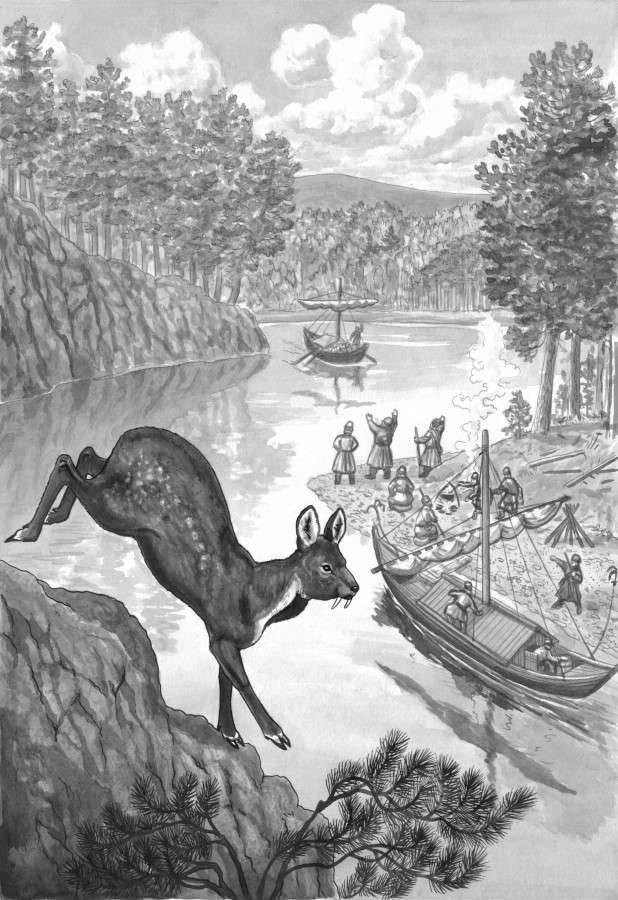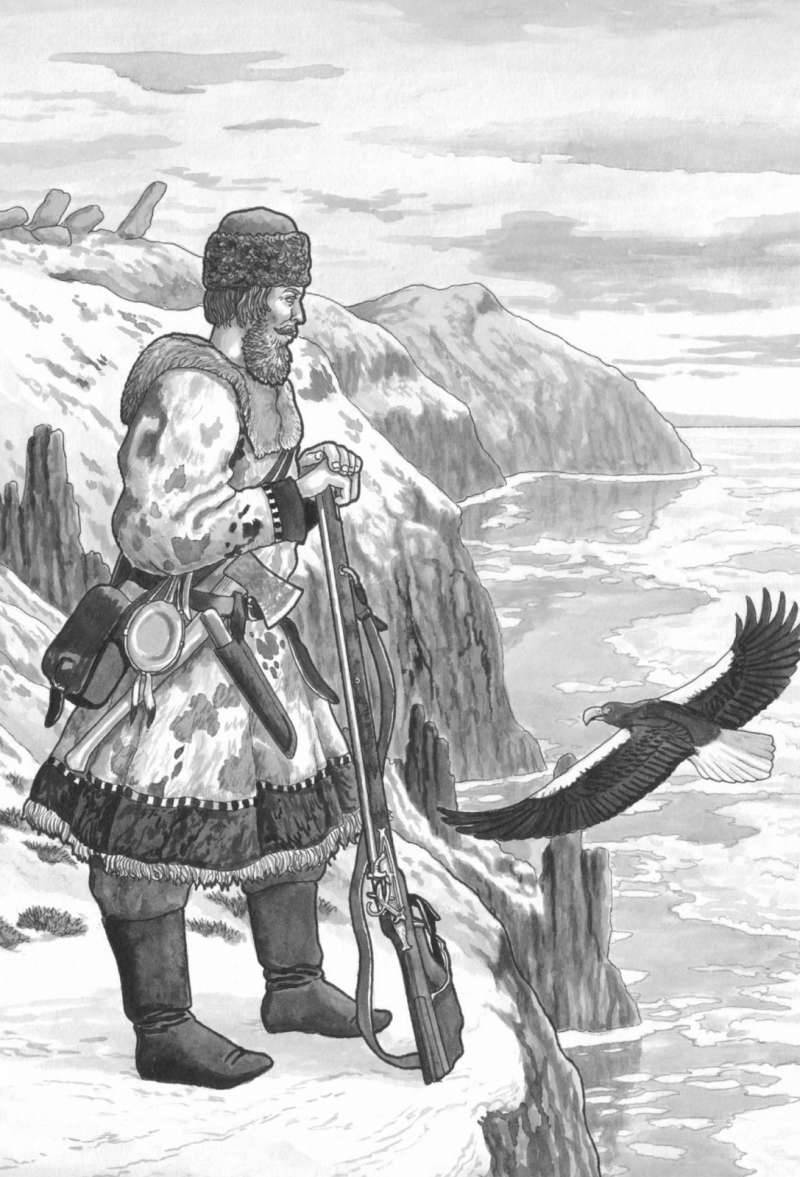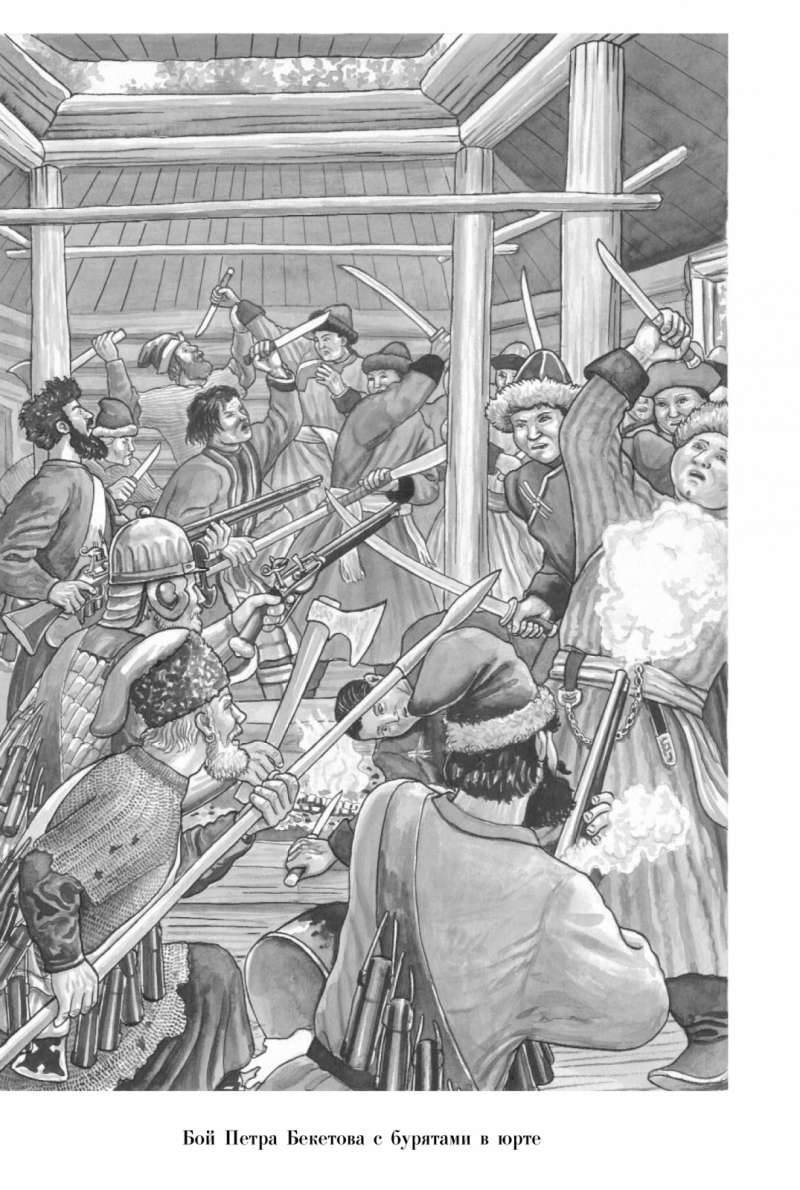Peter Beketov - the right conquistador
The biographer of Peter Beketov, EB Vershinin, believes that the date of birth of Peter Ivanovich may be related to the end of the 16th century. In general, Beketov first emerges in the written stories in the petition from 1627 year, where he asked for the appointment of artillery centurion in the Yenisei jail "So that I, your servant, dragging between the yard, starvation death is not dead." Apparently, Beketov belonged to a layer of provincial children of boyars, who stood below tenants and nobles of Moscow, but above the town children of boyars.
Interestingly, Pyotr Beketov was hustling about the position of the centurion not just like that, and having some information “from the floor” - in the fall of 1625, Obadney Firsov’s ataman who held this position drowned in Obi, and another significant Russian conquistador was a competitor . Be that as it may, in January 1627 was instructed to the governors of Tobolsk to make up Beketov's money and bread salary and send him to Yeniseisk.
Peter Beketov. Illustration of the artist, hunter and ethnographer Nikolai Fomin
In 1628, the Yenisei garrison consisted of the centurion Beketov, the ataman Perfilyev and 105 archers. In the spring of this year, Beketov set off on his first hike at the head of a squad of servicemen from 30 and 60 "industrial" people. The goal was to pacify the Lower Angara Tungus, who a year ago attacked Perfilyev’s detachment returning from the Ilima estuary. Beketov was supposed to influence the Tungus persuasion and "affection." It is hard to say how, but Peter Ivanovich coped with this task, and in the meantime, he built the Rybinsky Island in the lower reaches of the Angara River.
In the autumn of the same 1628, the city of Beketov was again sent up along the Angara, having all the service people under the command of all 19. The main task of Beketov was to get ahead of Khripunov’s large detachment. Going to the Angara in order to search for ore silver. However, the Yenisei authorities quite reasonably assumed that Khripunov would bring foreigners under the sovereign’s hand with robbery and violence, and if he robbed, he would leave, leaving the consequences of his campaign to clear up the Yeniseans. In general, this is how it turned out, but Khripunov did not leave, but died there on the Angara. As a result, Beketov managed to collect yasak from the Angarsk Tungus, not far ahead of Khripunov, and also managed to somehow get some sables from the Buryats and in the spring and summer 1629 returned to Yeniseisk, passing sable skins to the treasury 689.
30 in May 1631. Beketov with a detachment in 30 people went to "long-range service on the Lena River for one year." This year lasted 2 of the year and 3 of the month.
On Lena, Beketov built the first prince in Yakutia (on the right bank, below Yakutsk by 70 km). Beketov managed to convince (with a kind word and “fiery battle”) to recognize the Russian authorities to more than thirty Tyons. In addition to collecting yasak, Beketov began in Yakutia collecting the tenth duty from the sable crafts of private industrialists and Cossacks. He also dealt with disputes arising between them, and honestly turned in the fee “from the court cases” (96 sables) to the Yenisei treasury. In June, 1633 Mr. Beketov handed Lensky Ostrozhek to his son Boyory P. Khodyrev who had come to replace him, and returned to Yeniseisk, having sable and 2471 sable fur coats for delivery to the 25 treasury.
In 1635-1636 Beketov puts Olekminsky jail, makes trips to Vitim, Bolshoi Patom and "other side rivers" and returns almost from 20 with forty sables. According to the established, apparently, the sequence in the spring of 1638, he is sent to his annual service in the Lensky fortress to replace I. Galkin. It is interesting to note that by this time, Beketov had already lost the rank of centurion and was considered simply Yenisei’s son of Boyar. In the absence of sources, it is difficult to assess this change in Beketov’s service career. On the Middle Lena, Beketov found an alarming situation. Several local toyoons from the "sovereign's hand" were deposited, attacking the Russian people and yasak Yakuts. Moreover, shortly before the arrival of Beketov, the Yakuts “came by attack” under the Lensky burg. The initiator of the “shatness” was the prince of the Nuriktai volost Kiriney, who left Lena for Aldan with his kind. That is why Galkin and Beketov, having united their detachments, made a campaign against Cyrene, capturing 500 cows and 300 mares.
At the beginning of 1641, the city of Beketov submitted two petitions to the Siberian order. From the first one, it turns out that in Yeniseisk Beketov had a wife, children and "little people" (that is, slaves). In the absence of an explorer, the governors took horses from his yard to perform underwater duties, which died in the Ilimsky portage. Pyotr Ivanovich asked to save his yard from the “carriage of the wolf”, as well as from standing of servicemen, who were going to Eastern Siberia. In another petition Beketov briefly set out all his Siberian campaigns and asked for the appointment of his Cossack head in the place of B. Bolkoshin, who "is old and maimed, cannot serve such your sovereign long-distance service". In the Siberian order compiled a detailed certificate confirming the veracity of the petitioner. Order clerks estimated that Beketov’s campaigns brought the state a profit of 11 540 rubles. Beketov's request was satisfied, and 13 of February he received the memory of the appointment of Yenisei foot Cossacks as his head. Previously, his salary was 10 rubles, 6 rye cheats and 4 oats cheats. The new salary was equal to 20 rubles, but instead of Beketov’s bread salary, he was to receive land for arable land.
In 1637, the city of Beketov had 18 tithe of arable land and 15 fallow. Tillage was cultivated, most likely, by hired peasants. Beketov sold a part of his lands (apparently received after 1641 in the bread salary offset) to peasants S. Kostylnikov and P. Burmakin. Preserved (among others) one interesting collective Chelobitnaya Moscow, signed by Beketov. In it, the Yenisei Cossacks asked to lift the ban on trade in ysyrem (ie, serfs from aboriginal peoples captured or illegally purchased by service people).
In 1648, Mr .. Peter Beketov returned to the rank of son of the boyars with a decrease in the salary to 10 rubles. Apparently, as a result of this downgrade, Beketov went to Moscow, where 1 arrived on January 1651. The administration again compiled a certificate about Beketov’s services, recognized the validity of his claims, and issued an “English good cloth”, appointed a salary of 20 rubles. and 5 pood. salt, "and for our bread salary ordered him to serve with arable land." In addition to Beketov, salary in 20 rub. in the Yenisei garrison, he had only Ivan Galkin, who had attained the rank of the boyars' son.
However, the position of the head of Beketov, however, was not returned, and he went to Yeniseisk, where a new voivode, Afanasy Filippovich Pashkov, was already sitting.
In April, the Pashkov 1652 informed the Tomsk governor that he was going to send 100 people to Transbaikalia. At the head of the expedition, whose tasks included the exploration of silver deposits, was put Beketov. Along with the Cossacks, “eager industrial people” entered the squad. Under the leadership of Beketov were Pentecostals Ivan Maximov, Druzhina Popov, Ivan Kotelnikov and Maxim Urazov. Among the foremen, especially we note Ivan Gerasimov son Chebychakov. In early June, 1652, Mr. Peter Beketov, spoke on his last trip.

Meeting Peter Beketov and Ivan Maximov. Illustration of Nikolai Fomin.
Since the Cossacks reached the Bratsk prison only after two months, it became clear to Beketov that the unit would not be able to reach the final goal in the summer, and he decided to winter on the southern shore of Baikal. However, he also sent 12 Cossacks led by I. Maximov from Bratsk fortress “lightly through the Barguzinsky fortress to Irgene Lake and to the great river Shilka”. With Maximov there were already those who were on Irgene Sofonov and Chebychakov. Calculation Peter Ivanovich was quite understandable. Having ordered Pashkov to go to Selenga and Khiloka (in the sources of the XVII century - the river Kilka), Beketov did not have anyone in the detachment who knew this water route. Maximov was supposed to go through the Trans-Baikal steppes to the Irgene Lake, where the upper reaches of the Khilok River were located, and go down this river towards Beketov.
It must be said that this step is very interesting precisely from the point of view of Beketov’s characterization as an organizer and traveler. He sends the devil knows how far a part of his squad is, intending to meet with them on a territory about which only fragmentary information and the names of rivers inhabited by hostile tribes are known - to prepare the rest of his campaign. You have to be very firmly confident in your people to do this. But in general, the idea was very good, and, as practice has shown, it was successfully implemented.
The main detachment of Beketov, having passed the left tributary of the Ogara of Osu, was attacked at night by the Buryats who were wandering “to the edge of Lake Baikal”. The Cossacks fought back, while the Buryats "boasted" not to miss the servicemen for Baikal. Knowing well the nomads, Beketov understood that it was impossible for him to let down such impudence. In response, he detached Kotelnikov's detachment, who attacked the “camps” of the Buryats, killed a 12 man in a battle, captured several prisoners, and the Cossacks themselves, “the whole package came all healthy”. Among the prisoners was discovered the wife of the Prince of Verkhny Yasak, Torom (who had not arrived on time), which Beketov returned to the Verkholensky prison.
Fight of P. Beketov with the Buryats in a yurt. Illustration of Nikolai Fomin.
Having teamed up with the party of Maximov, which prepared the planks to lift the entire detachment along Khilok, by the middle of October Beretov set up the Irgurg fortress, and on October 19 the Cossacks started to go rafting down Ingoda. Beketov obviously expected the winter to get to the mouth of the Nercha. However, having sailed along the Ingoda 10 versts, the detachment was met by an early freeze up of the river. A winter hut with fortifications was built here, where part of the reserves was laid. 20 people remained in the cabin, 10 Cossacks under the command of M. Urazov were sent to the mouth of Nerchi, and with the rest Beketov returned to the Irgen fortress.
On Shilka, Beketov was going to build, in accordance with the order of Pashkov, a large prison. The Cossacks even sowed spring bread on the chosen place. However, the construction of Russian fortifications and the winter gathering of the yasak forced the Tungus tribes to take up weapon. The Russian detachment sat in the siege (apparently, in the island built by Urazov). Tungus drove the horses and trampled down the bread. Famine began among the Cossacks, as the Tungus were not allowed to engage in fishing. In his opponents, Beketov recognized those who had recently brought tribute to him. There were neither riverboats, nor horses of the Yeniseans. They had the only way to retreat - on rafts, down Shilka to Amur.
On Amur at that time, the “most serious” Russian force was the “army” of the orderly man Onufrii Stepanov, the official successor of E.P. Khabarova. To him the Amur current brought the Cossacks Beketov. By Stepanov, the Cossacks Beketov arrived in different groups. At the end of June, 1654 of the Yeniseyts joined Stepanov, and a few days later Peter Beketov himself appeared, who "beat the whole Cossack army with his brow to live on the great Amur River before the sovereign's decree." The hereditary son of Boyar and the former head of the Yenisei garrison submitted to Stepanov, who until recently was only a gunner with the rank of Esaula. E. Vershinin believes that behind this and other stingy testimonies lurks the character of Beketov - a man balanced and even gentle. But the steel rod of this character is beyond doubt.
The fate of Beketov on Amur is known only up to a certain point. In the autumn of 1654, Stepanov’s army built the Kumar burg. 13 March 1655 the jail was besieged by the 10-thousandth Manchu army. The Cossacks survived the bombardment of the fortress for several days, repulsed all the attacks and made a raid themselves. At the end of the siege, Stepanov composed a service name list of Cossacks who “fought clearly”. Beketov's petition is also attached to Stepanov’s unsubscriptions. She was also signed by foreman Ivan Gerasimov Chebychakov and 14 ordinary Cossacks. In this document, Beketov summarized the reasons for leaving Shilka and asked to welcome the service shown in defending the Kumar prison. This document, dated April 1655, is so far the latest reliable news about Beketov.
It seems to me, ”concludes Beketov Vershinin’s biographical essay,“ that he did not return from Amur Beketov. In 1655-1658 O. Stepanov with his army literally wandered along the Amur. The Cossacks wintered in hastily set ostrogs and collected jasak from ethnic tribes that suffered greatly from the hostilities between the Russians and the Manchus. The threat of famine and the Manchurian danger constantly hung over Stepanov's army. Amur peoples, angry with the cruelty of E.P. Khabarov, mercilessly exterminated small detachments of Cossacks who risked acting at their own peril and risk. Maybe luck changed the old explorer on that memorable day of 30 June 1658. How the Enisei son of boyar PI met his mortal hour. Beketov we, most likely, will never know ...
In the census book of Yenisei district 1669, the widow of the boyar’s son Peter Beketov is named among the sellers of the land. Perhaps, after the death of her husband, she went back to the Urals, why we do not find the descendants of Pyotr Ivanovich in the service environment of Yeniseisk.
Analyzing the activities of Beketov, you pay attention to how much this person has always tried to act in accordance with the then legislation and in accordance with the rules. He considered himself worthy of a rank — he wrote papers, went to Moscow; considered himself unjustly offended - did the same. Beketov (me personally) is almost impossible to imagine trying amanats for his own pleasure (as the Yakut voivode Golovnin did to them); or “on the pogrom for the saber” of the already explained Tunguses (which Galkin was a sinner). Yes, I could boast a bit - but what kind of soldier does not like?
The soldier - I knowingly used this word - by the nature of Peter Beketov was the direct predecessor of the regular army. Disciplined, neat and not devoid of signs of humanity. Yes, he advocated the seizure of slaves and the trade in them in Siberia - well, this is an everyday matter.


Information